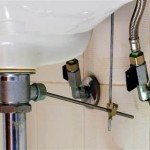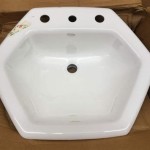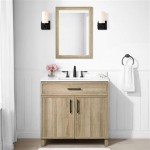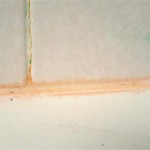Here's an article on Sears bathroom vanities, written according to your specifications:
Sears Bathroom Vanities: A Comprehensive Overview
The bathroom vanity serves as a focal point in any bathroom, providing both functionality and aesthetic appeal. Sears, a retailer with a long history in the American home goods market, has offered a variety of bathroom vanities designed to meet diverse needs and preferences. This article provides a comprehensive overview of Sears bathroom vanities, examining their features, styles, materials, and considerations for selection.
Sears' collection of bathroom vanities has historically spanned a range of designs, from traditional to contemporary, and has catered to different bathroom sizes and budgets. While the Sears brand itself no longer manufactures many of these items directly due to restructuring, various vendors offered products through the Sears marketplace, maintaining a selection of vanities that reflect evolving trends in bathroom design.
Understanding Different Styles of Sears Bathroom Vanities
Sears' offerings in bathroom vanities encompassed a range of styles to complement various bathroom aesthetics. Understanding these styles is crucial for homeowners looking to find a vanity that seamlessly integrates with their existing or planned bathroom design.
Traditional Vanities: These vanities often feature ornate details, raised panel doors, and classic hardware. Common materials include solid wood or wood veneers with a rich finish such as cherry, oak, or mahogany. Traditional vanities frequently incorporate elements like turned legs, carved accents, and intricate moldings to evoke a sense of timeless elegance.
Contemporary Vanities: In contrast to traditional styles, contemporary vanities emphasize clean lines, minimalistic design, and a focus on functionality. They typically feature sleek surfaces, flat-panel doors, and modern hardware. Materials often include engineered wood, glass, metal, and composite materials with finishes such as high-gloss white, grey, or black.
Transitional Vanities: Transitional vanities bridge the gap between traditional and contemporary styles. They combine elements of both, offering a versatile aesthetic that can complement a variety of bathroom designs. These vanities may feature a blend of clean lines with subtle detailing, and they often incorporate a mix of materials and finishes.
Floating Vanities: Also known as wall-mounted vanities, these vanities are installed directly onto the wall, creating a sense of spaciousness and allowing for easy cleaning underneath. Floating vanities are particularly well-suited for modern and minimalist bathrooms.
Corner Vanities: Designed to fit snugly into a corner, these vanities are a space-saving solution for smaller bathrooms. They maximize the available space while still providing adequate storage and counter space.
Key Materials Utilized in Sears Bathroom Vanities
The materials used in constructing bathroom vanities significantly impact their durability, appearance, and cost. Sears has offered vanities crafted from a variety of materials, each with its own advantages and disadvantages.
Solid Wood: Solid wood vanities are known for their durability, strength, and natural beauty. They are typically more expensive than vanities made from engineered wood, but they offer a timeless aesthetic and can be refinished or repaired if necessary. Common wood species used include oak, maple, cherry, and birch.
Engineered Wood: Engineered wood, such as plywood or MDF (medium-density fiberboard), is a cost-effective alternative to solid wood. It is less prone to warping and cracking than solid wood, and it can be finished to resemble a variety of wood species. Engineered wood is often used for the cabinet boxes and doors of vanities.
Wood Veneers: Wood veneers are thin slices of real wood that are applied over a core of engineered wood. They provide the look and feel of solid wood at a lower cost. Wood veneers can be used to create a variety of decorative effects, such as grain matching and book-matching.
Laminates: Laminates are synthetic materials that are bonded to a core of engineered wood. They are durable, water-resistant, and easy to clean. Laminate vanities are available in a wide range of colors and patterns.
Stone Countertops: Countertops for bathroom vanities are often made from natural stone such as granite, marble, or quartz. These materials are durable, heat-resistant, and stain-resistant. Each type of stone has its own unique appearance and characteristics.
Solid Surface Countertops: Solid surface countertops are made from a blend of acrylic or polyester resins and mineral fillers. They are non-porous, easy to clean, and can be repaired if scratched or damaged. Solid surface countertops are available in a variety of colors and patterns.
Cultured Marble Countertops: Cultured marble is a man-made material that is made from a mixture of marble dust and resins. It is less expensive than natural marble, but it still provides a similar look and feel. Cultured marble is non-porous and easy to clean.
Factors to Consider When Selecting a Sears Bathroom Vanity
Choosing the right bathroom vanity requires careful consideration of several factors, including size, storage needs, style, and budget. By evaluating these factors, homeowners can select a vanity that meets their specific needs and complements their bathroom space.
Size and Layout: Before selecting a vanity, it is essential to measure the available space in the bathroom. Consider the width, depth, and height of the vanity, as well as the placement of plumbing fixtures and other bathroom elements. Ensure that the vanity will fit comfortably in the space and allow for adequate clearance for doors and drawers.
Storage Needs: Evaluate the storage needs of the bathroom and choose a vanity that provides adequate space for storing toiletries, towels, and other bathroom essentials. Consider the number of drawers, shelves, and cabinets offered by the vanity.
Sink Configuration: Bathroom vanities are available with a variety of sink configurations, including single-sink, double-sink, and vessel sink options. Consider the number of users who will be using the vanity and choose a configuration that meets their needs. Double-sink vanities are ideal for master bathrooms where two people often use the space simultaneously.
Countertop Material: The countertop material should be durable, water-resistant, and easy to clean. Consider the pros and cons of different countertop materials, such as granite, marble, quartz, solid surface, and cultured marble, and choose a material that meets your needs and budget.
Style and Finish: Choose a vanity style that complements the overall aesthetic of the bathroom. Consider the color, finish, and hardware of the vanity, and ensure that it coordinates with other bathroom fixtures and accessories.
Budget: Set a budget for the bathroom vanity before beginning the selection process. Prices for bathroom vanities can vary widely, depending on the size, materials, and style. Consider the long-term value of the vanity and choose a product that offers a good balance of quality, durability, and affordability.
Installation: Determine whether the vanity will be installed by a professional or by the homeowner. Some vanities require professional installation, particularly those that involve plumbing or electrical work. Consider the cost of installation when budgeting for the vanity.
Brand Reputation: While Sears itself may not be the manufacturer, consider the reputation of the vendors selling vanities through the Sears marketplace. Research customer reviews and ratings to assess the quality and reliability of the products. Pay attention to reviews that mention issues such as durability, finish quality, and ease of installation.
Warranty: Check the warranty offered by the manufacturer or vendor. A good warranty can provide peace of mind and protect against defects in materials and workmanship. Understand the terms and conditions of the warranty before making a purchase.
In conclusion, while the Sears brand has evolved, the considerations for selecting a quality bathroom vanity remain constant. These include style preferences, material durability, and overall budget. By carefully assessing these factors, consumers can find the ideal vanity to enhance their bathroom space.

Bathroom Vanity Remodeling And Design Ideas

1981 Sears Bathroom Remodeling Oak Cabinets Vanity Faucet Vintage Print Ad

1982 Sears Bathroom Furnishings Print Ad Real Wood Where It Counts

48 Modern Bathroom Vanity With Color Faucet And Linen Side Cabinet Option

Whiting 60 Single Bathroom Vanity Set 1200 Interior Design

Del Ray Sears Bungalow Craftsman Bathroom Dc Metro By Winn Design Build Houzz 1970s Remodel

Ariel Magnolia 73 In W X 22 D 36 H Bath Vanity White With Carrara Marble Top Basins S073dcw2ovowht The Home Depot

Ariel Magnolia 73 In W X 22 D 36 H Bath Vanity White With Carrara Marble Top Basins S073dcw2ovowht The Home Depot

Sears Pisces Vintage Doll Furniture Nursery Vanity Bathroom Kitchen Lot Of 22
Related Posts







